Description of the Permanent Continuing Education Seminars of the Health Education System for Well-being
Main Article Content
Keywords
Learning, Continuing, Education, Distance
Abstract
Background: Between 2020 and 2023, the Health Education System for Well-being (SiESABI) implemented eleven Permanent Continuing Education Seminars (SPEC) with the aim of supporting the adoption of a healthcare model based on Primary Health Care (PHC).
Objective: To describe the SPEC, document their scope, identify areas of opportunity, and plan their transfer to the health sector.
Material and methods: A total of 248,994 records from SiESABI were analyzed, including demographic, employment, attendance, and qualification variables.
Results: SPEC covered 254 sessions on health research, nursing, PHC, mental health, medicine and health, quality and safety, nutrition, oral health, health teaching, COVID-19, and healthy aging. Nearly 250,000 attendances, mostly by women (69.5%), young individuals (32, Q1 = 27, Q3 = 40 years), with a bachelor's degree (61.2%), working in nursing (55.6%), and in the medical field (18.8%). Almost half (48.6%) of the attendees worked in the first level of care (34.7%) for INSABI or SSA (36.1%). Most frequent places of residence were Oaxaca (14.6%) and the State of Mexico (13.7%). Median attendance per session was 789.5 (Q1 = 567.4, Q3 = 1148.5). Attendance in the first month (599.8 ± 217.5) nearly halves in the second month (389.9 ± 218.0), becoming occasional from the sixth month onwards.
Conclusions: SPEC offered by SiESABI have established as a mass education strategy for healthcare personnel. Strengthening mandatory subscription and increasing local participation is recommended, along with improving the identification of training needs, monitoring coverage, and evaluating performance and health outcomes of educational interventions.
References
Ochoa Gutiérrez R, Balderas Gutiérrez KE. Educación continua, educación permanente y aprendizaje a lo largo de la vida: coincidencias y divergencias conceptuales. Revista Andina de Educación. 2021;4:67-73. doi: 10.32719/26312816.2021.4.2.8.
Secretaría de Gobernación. Decreto por el que se reforman, adicionan y derogan diversas disposiciones de la Ley General de Salud, para regular el Sistema de Salud para el Bienestar. Disponible en: https://dof.gob.mx/nota_detalle.php?codigo=5690282&fecha=29/05/2023#gsc.tab=0 (2023).
Toledo-Ortiz R, González-Rojas J, Mendoza-Velásquez J, et al. La plataforma educativa del INSABI a partir del Covid-19. Salud Publica Mex. 2023;65:306-307.
Toledo-Ortiz R, González-Rojas J, Molina-Vallejo L, et al. Desarrollo de la estrategia educativa del INSABI: una lección aprendida a partir de la epidemia de COVID-19. Rev Med Inst Mex Seguro Soc. 2023;61:386-398.
Secretaría de Gobernación. Acuerdo por el que se emite el Modelo de Atención a la Salud para el Bienestar (MAS-BIENESTAR). Disponible en: https://dof.gob.mx/nota_detalle.php?codigo=5669707&fecha=25/10/2022#gsc.tab=0
INSABI. Sistema Educativo de Salud para el Bienestar. Disponible en: https://capacitacion.insabi.gob.mx/siesabi-aulavirtual/ (2023, accessed 25/01/2023 2023).
Ottesen TD, Montoya RL, Ogunleye TD, et al. Implementation and Impact Evaluation of a Virtual Orthopaedic Continuing Medical Education Conference in a Low-Resource Country. J Surg Educ. 2021;78:1629-1636. 20210208. doi: 10.1016/j.jsurg.2021.01.002.
Sarabipour S. Virtual conferences raise standards for accessibility and interactions. Elife. 2020;9:20201104. doi: 10.7554/eLife.62668.
Rubinger L, Gazendam A, Ekhtiari S, et al. Maximizing virtual meetings and conferences: a review of best practices. Int Orthop. 2020;44:1461-1466. doi: 10.1007/s00264-020-04615-9.
Gutierréz HC. Hacia la construcción de una línea de investigación (Seminario-Taller). U. Cooperativa de Colombia, 2004.
Clark HA. The Virtual Reality of Science Conferences. ACS Sens. 2021;6:588-589. doi: 10.1021/acssensors.1c00449.
Hahn TW. Virtual Noon Conferences: Providing Resident Education and Wellness During the COVID-19 Pandemic. PRiMER. 2020;4:17. 20200814. doi: 10.22454/PRiMER.2020.364166.
INSABI. Modelo Educativo Basado en Competencias en el marco del Modelo de Atención a la Salud para el Bienestar (MAS-Bienestar). Disponible en: https://www.gob.mx/insabi/documentos/modelo-educativo-basado-en-competencias?state=published.
Kirkpatrick D, Kirkpatrick J. Evaluating training programs: The four levels. Berrett-Koehler Publishers. 2006.
Yardley S, Dornan T. Kirkpatrick’s levels and education ‘evidence’. Medical Education. 2012;46:97-106.
Shen N, Yufe S, Saadatfard O, et al. Rebooting Kirkpatrick: Integrating Information System Theory Into the Evaluation of Web-based Continuing Professional Development Interventions for Interprofessional Education. J Contin Educ Health Prof. 2017;37:137-146. doi: 10.1097/CEH.0000000000000154.
Vaona A, Banzi R, Kwag KH, et al. E-learning for health professionals. Cochrane Database Syst Rev. 2018;1:CD011736. 20180121. doi: 10.1002/14651858.CD011736.pub2.
Sinclair PM, Kable A, Levett-Jones T, et al. The effectiveness of Internet-based e-learning on clinician behaviour and patient outcomes: A systematic review. Int J Nurs Stud. 2016;57:70-81. 20160204. doi: 10.1016/j.ijnurstu.2016.01.011.
Richmond H, Copsey B, Hall AM, et al. A systematic review and meta-analysis of online versus alternative methods for training licensed health care professionals to deliver clinical interventions. BMC Med Educ. 2017;17:227. doi: 10.1186/s12909-017-1047-4.
VanNieuwenborg L, Goossens M, De Lepeleire J, et al. Continuing medical education for general practitioners: a practice format. Postgrad Med J. 2016;92:217-222. doi: 10.1136/postgradmedj-2015-133662.
Choe RC, Scuric Z, Eshkol E, et al. Student Satisfaction and Learning Outcomes in Asynchronous Online Lecture Videos. CBE Life Sci Educ. 2019;18:ar55. doi: 10.1187/cbe.18-08-0171.
Mayer RE. Multimedia learning. 2nd ed. Cambridge, UK: Cambridge University Press; 2009.
Parmar JK, L'Heureux T, Anderson S, et al. Optimizing the integration of family caregivers in the delivery of person-centered care: evaluation of an educational program for the healthcare workforce. BMC Health Serv Res. 2022;22:364. doi: 10.1186/s12913-022-07689-w.
Seymour-Walsh AE, Weber A, Bell A. Pedagogical foundations to online lectures in health professions education. Rural Remote Health 2020;20:6038. 20200529. doi: 10.22605/rrh6038.
Guo T, Sun Y, Li G. Knowledge, Attitude, and Practice regarding Narrative Medicine among Chinese Medical Personnel: An Online Cross-Sectional Survey. Comput Math Methods Med. 2022;2022:3329360. doi: 10.1155/2022/3329360.
Albumijdad JR, Alismail AS, Albesher MA, et al. Attitude, knowledge, and barriers towards research analysis and writing in Saudi Arabia. J Family Med Prim Care. 2022;11:2123-2128. doi: 10.4103/jfmpc.jfmpc_1991_21.
Wilkinson A, While AE, Roberts J. Measurement of information and communication technology experience and attitudes to e-learning of students in the healthcare professions: integrative review. J Adv Nurs. 2009;65:755-772. doi: 10.1111/j.1365-2648.2008.04924.x.
de Navarra G. Guía para medir la satisfacción respecto a los servicios prestados. Navarra, España. Disponible en: http://www navarra es/NR/rdonlyres/5A006CFC-7EBC-4A3F-9FA5-4574ADA817D8/0/GuiaPARAMEDIRLASATISFACCION2012 pdf 2009.
Johnson DL. Virtual conferences democratize access to science. Nat Med. 2022;28:1335. doi: 10.1038/s41591-022-01849-5.


